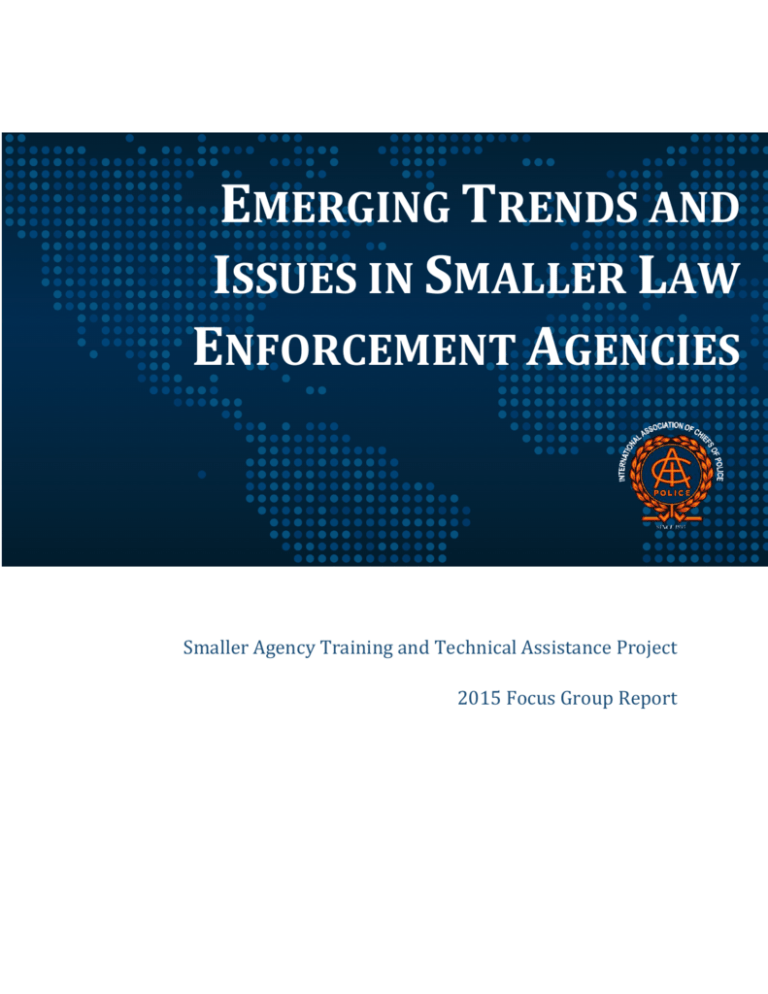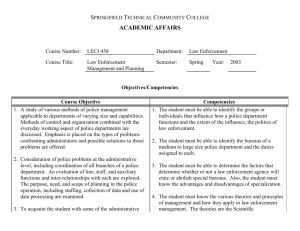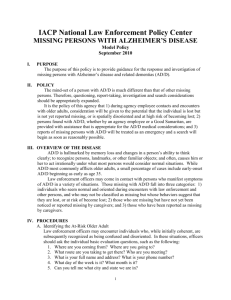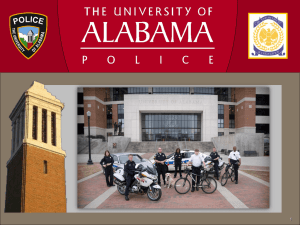emerging trends and issues in smaller law enforcement agencies
advertisement

EMERGING TRENDS AND ISSUES IN SMALLER LAW ENFORCEMENT AGENCIES Smaller Agency Training and Technical Assistance Project 2015 Focus Group Report TABLE OF CONTENTS Introduction Challenges, Innovations, and Recommendations 1. Controlling the Message 2. Technology 3. Training 4. Recruitment & Retention 5. Community Policing & Engagement 6. Working with City Leaders 7. Voice of the Profession 8. Conclusion Appendix A: Focus Group Participant List 2 INTRODUCTION Introduction The landscape of policing in America is changing rapidly. It is impacted by recent high profile events covered by the media, changing expectations from the community, and an increasing reliance on new technologies. While the missions of all 18,000 law enforcement agencies across America remain similar, the methods of operation, practices, and access to resources and training vary greatly. Outside of the attention given to high profile agencies in major cities, there’s a different picture across the rest of the country. Smaller agencies in communities of 50,000 or less represent the majority of law enforcement agencies. The goal of this document is to report on current trends, emerging issues, and concerns of smaller law enforcement agencies, so that we can identify and address current and future needs. In order for major support initiatives to move forward, innovative outside the box thinking is needed to face future complex issues that smaller agencies will encounter. IACP’s Smaller Agency and New Police Chiefs Support In 1997, the IACP began offering customized training and technical assistance to smaller law enforcement agencies with funding from the U.S. Department of Justice Bureau of Justice Assistance (BJA). Over the years, the Smaller Law Enforcement Agency Training and Technical Assistance Program has evolved and developed new resources to meet the needs of smaller departments. Services include the IACP Annual Conference Smaller Agency Workshop Track, the Police Chief’s Desk Reference, the Big Ideas for Smaller Agencies newsletter, a series of online webinar presentations, and more. In 2003, the program was expanded to include the New Police Chiefs Mentoring project. The project launched a new web-based mentoring database in partnership with IACP’s Discover Policing program in 2013, bringing new options and greater flexibility for mentors and new chiefs. The focus of the mentoring project is to provide newer police chiefs from smaller agencies with access to seasoned chiefs from similar sized agencies to learn how they achieved success and resolved similar problems. The project is designed to render leadership and policy guidance to new chiefs as they begin their tenure through mentoring assistance and through the dissemination of the Police Chiefs Desk Reference. After nearly two decades of continuous support from BJA, the Smaller Law Enforcement Agency Training and Technical Assistance Program will be transitioning to a new model of service in 2016. Focus Group Overview The mission, training needs, and technological requirements of smaller law enforcement agencies will only continue to grow in the 21st century. In January 2015, IACP and BJA brought together a group of smaller agency representatives to get a snapshot of the current conditions in smaller agencies and to discuss how IACP can better support them moving forward. 3 The meeting had five key goals: 1. Identify the current trends, emerging issues, and concerns of policing communities with fewer than 50,000 residents. 2. Identify best practices that are working well for smaller agencies. 3. Determine how to preserve the legacy of IACP’s BJA funded Smaller Agency Training and Technical Assistance Program. 4. Explore what existing IACP resources can be promoted or enhanced to better serve smaller agencies. 5. Develop ideas for future projects and resources to meet emerging smaller law enforcement agency needs. Participants represented smaller metropolitan, suburban, rural, and tribal law enforcement agencies from a variety of geographic areas. Given the timing of the meeting, participants were heavily influenced by the recent events in Ferguson, Missouri and the ensuing debates on police-community relations, as well as the lingering effects of the 2008 economic recession. The meeting was split up into two parts: a big-picture discussion of the needs, challenges, and successes of today’s smaller law enforcement agencies and a focused conversation to determine specific recommendations based on the big picture discussion. This report outlines the key areas of interest and concern identified during the meeting. These areas are largely the same subjects of primary concern to all law enforcement agencies today, but the focus group participants explored specific smaller law enforcement agency considerations within these topics. Recommendations include short- and long-term ideas that IACP, BJA, and other justice partners could implement to meet smaller agency needs. 1. CONTROLLING THE MESSAGE In today’s digital world, controlling the message of a critical incident before the media and community fill the void with speculation can be particularly challenging for smaller agencies who may lack staffing for an immediate around-the-clock public relations response. A focus group participant stated: “you’re on YouTube before you get back to the station, and you’re receiving questions before officers have secured the scene.” Being able to control the message begins with human relations and building trust with the public that information will become available at the earliest possible time. It may be difficult to comment on an ongoing investigation, but the public and media have come to expect immediate gratification in the digital world. “The first thing I do is call a press conference, if you don’t give something to them, they’ll go out and speculate,” said a participant. In light of recent events that have garnered national news coverage, many participants believed a negative narrative against law enforcement is growing. On the positive side, smaller agencies are often able to control the message in their community more easily than large agencies. Smaller agencies can cultivate more personal relationships with the media, community leaders, and public. 4 IACP Executive Director Vincent Talucci said “we’re not going to win this fight by screaming louder, we want to be in strategic communications mode, not crisis mode.” Agencies should also recognize that reaching the newer generation requires diversification on how information is disseminated, particularly through the use of social media. “People rarely read press releases anymore, so we started releasing videos on our website, and the news stations started including the footage into their news coverage,” stated a participant. Participants discussed the importance of sharing positive stories about your officers and community programs as a way to counter the serious stories and potentially negative perceptions. Developing trust with the public, communicating information on a timely basis, and diversifying outlets to release information are keys to ensuring your message is heard and accepted throughout the community. Recommendations: o Develop and promote tools for small agencies about crafting and sharing their mission through media relations and social media with special attention to officer success stories. o Share best practices on how to engage and build partnerships with local media. o Create or promote tools on how to create videos using low or no-cost resources. 2. TECHNOLOGY Technology is revolutionizing the world—both in how law enforcement conducts their jobs and how criminals operate today. Access to new technologies can be challenging for small agencies because they may lack the necessary resources to purchase new equipment, the technical background and training to assess product options, and the means to thoroughly explain technology needs to city officials. And while the national trend may be to place more technology in law enforcement agencies, sometimes the new technologies may be more than a small community really needs. Only in the past 10-15 years have body cameras, dashboard cameras, and electro-muscular disruption technology seen mainstream adoption in law enforcement. Participants noted concerns about unfunded federal mandates to implement body cameras and other new technologies, the technology is rapidly changing and can be expensive to maintain. For example, one small agency reported having to incur $20,000 per year in data storage fees for the 32 body cameras they recently purchased. In addition, there could potentially be thousands of dollars in unforeseen costs for responding to open records laws that may require the agency to clean any personal information out of the video before releasing to the public. One chief said, “Body camera requirements could circumvent us getting the patrol cars we need. We only have two incidents per year – body cameras would be boring.” Smaller agencies must be very deliberate when purchasing new technology and not fall into the trap of purchasing the latest and greatest gadget before it has been tested and vetted. Smaller agencies often have the benefit of first seeing how larger agencies overcome pitfalls and manage successes with new technologies before implementing them in their own agencies. On the other hand, it was noted that smaller agencies sometimes have the advantage of being more nimble, making it easier to begin using a new technology given the smaller scale of implementation. However, a challenge smaller agencies face is that IT employees and city officials in small towns may not be familiar with 5 the needs and demands of police work, creating a separation of understanding when discussing or implementing new technologies. While new technology may help law enforcement officers perform their jobs more efficiently, many small communities cannot incur the expense. Significant consideration needs to be paid to legal implications, policy, training, and long-term maintenance expenses before adopting new technologies. Focus group participants reported that what makes smaller communities great, is the individual connection officers can have with the community and to caution against how some technologies can impersonalize communication and remove that personal connection that is desired by local residents. Recommendations: o Provide guidance on talking to city officials about law enforcement technology needs. Ensure that guidance is worded in such a way that it can be understood by people without advanced technology backgrounds. o Develop white papers on how to evaluate and adapt new technologies successfully. o Develop a list of core competencies essential in small agency policing including opportunities and potential pitfalls associated with modern law enforcement technology. o Provide funding or information on potential funding sources for smaller agencies to implement and maintain new technology. 3. TRAINING The biggest issue smaller agencies encounter with training is manpower and the ability to backfill an officer’s position. When an officer is attending a training, another colleague must cover their shift in order to have appropriate staffing in the office or on patrol. This may involve a shortage of staff or incurring overtime costs. Participants commented that they could usually afford training and even limited travel expenses from their training budgets, but the cost to backfill a position is typically what prevents officers from attending specialized training on areas of interest or to advance their professional development. Core training, however, is met with an opposite response, participants reported the amount of training officers are mandated to receive has increased exponentially over the past decade. “We have never had officers saying they’ve had too much training until now, they never have a chance to use what they’ve learned,” said one chief. Providing opportunities for officers to attend trainings outside of state mandates courses can be difficult to accomplish due to funding and staffing levels. One chief explained a common challenge: "Police are protective of their camp, they don’t like reaching out.” However, many chiefs do look outside the box to partner with outside agencies to reduce costs and share expertise. Given the challenge many small agency officers have with gaining exposure to certain types of cases, some agencies had success with sending officers on ‘ride-alongs’ with officers from larger agencies to learn from their practices and equipment. Smaller agency chiefs in some areas are teaming up to develop 6 a cadre of instructors to jointly train staff from multiple agencies for state-required standard trainings and other featured topics. Recommendations: o Expand cost-effective online training offered by the IACP. o Promote or develop a standard training curriculum for leadership. o Continue to offer no-cost and fee-for-service leadership training. o Make available middle management programs for sergeants, lieutenants, and captains. o Partner with colleges and universities to promote continuing education and training towards advanced degrees that recognize courses offered through IACP for college credit. o Partner with more state POST agencies to ensure that training courses offered through IACP are accepted for credit. o Offer funding to offset the cost of backfilling officers for training. 4. RECRUITMENT & RETENTION Hiring and retaining quality employees in smaller agencies is a daunting task for two major reasons: 1) larger agencies can offer greater compensation and benefits and 2) internal promotions and opportunities are typically limited, only becoming available when other officers retire. These challenges make it difficult for agency leaders to maintain appropriate staffing levels and generate job satisfaction and positive morale. The turnover resulting from these challenges is particularly difficult for smaller agencies, given the significant time and financial investments made to hire and train an officer. When an officer departs from a smaller agency, focus group participants reported it can take up to 18 months to recruit and train a replacement. Chiefs sometimes face pressure to keep problem officers or hire part-time officers in order to cover patrols. Chiefs were cautious of this practice as part-time officers can also work at other agencies that operate under different policies and where their hours may be unregulated, opening a host of legal considerations. Agencies place special emphasis on the hiring process to ensure new hires not only have the ability to perform the job, but are the right fit for their community. A participant described how they involve two civilians from the community to sit on the hiring board, asking them if they’d want this person to serve in their community. Chiefs also discussed the importance of recruiting candidates from under-represented communities, so that the department is representative of the community it serves. Pre-employment screening is a particular concern for smaller agency chiefs. Many of them do not have human resources departments or the necessary career experience in this topic. Agencies often contract out background checks or attend an outside training, which can be costly and may not be comprehensive enough. States have differing requirements for validation, making it both hard for departments to understand the requirements in their own jurisdiction and difficult to tailor resources to assist law enforcement with this topic. Participants noted that separate procedures are needed for lateral hires to determine the circumstances upon leaving their previous agency and if there are any concerns in their employment history. 7 Faster career ladders and the abundance of specialized units in larger agencies are typical motivators for an officer to jump to another agency. After several years on patrol, career advancement opportunities for officers in smaller agencies become bottlenecked, often delayed until a senior officer leaves or retires. Even then, smaller agencies find it hard to engage officers in professional development that will prepare them for greater responsibilities. This creates a pool of candidates who are eligible for promotion but are not necessarily qualified for the position. In order to protect the investment in personnel, several smaller agency chiefs stated they actively seek to provide more operational/organizational opportunities to officers and empower them to be leaders by rotating them periodically into special assignments. Chiefs also found task forces and other regional or local law enforcement partnerships to be good ways to offer professional development and keep staff engaged. Agencies also looked to strengthen the bond between officers and citizens to encourage engagement and retention. Several agencies let officers take the lead on community events that fell within their special interest areas, such as soap box derbies or sports programs. Agencies need to challenge themselves to create opportunities for their officers outside of the traditional career ladder to keep their employees motivated and engaged. One benefit smaller departments have is the ability to more easily engage staff and give them a voice in day-to-day operations and future planning. Participants shared a few examples of how they do this: emailing staff during budget planning for ideas on upcoming expenses; sharing general order changes with staff for comment before they are finalized; offering a suggestion box; scheduling open door office hours with the chief; and debriefing regularly on how things are going and what can be done differently. These strategies can make officers feel like valued team players and encourage retention. Recommendations: o Develop resources for pre-employment screening with basic guidance on background check procedures and a prospectus of requirements for each state. Separate guidance should be provided on lateral and new officers. o Share best practices in offering professional development opportunities for small agency officers to aid in developing future leaders and improving retention. o Develop tools to help smaller agencies recruit and hire candidates from underrepresented communities. o Collaborate with military recruitment to develop best practices guide on hiring and retention practices. 5. COMMUNITY POLICING & ENGAGEMENT With a shorter chain of command, it is easier to get everyone on board with a shared philosophy and mission. For many smaller agencies these philosophies are rooted in community policing. Smaller agencies have the advantage of being able to interact with community members on a more personal level than some larger agencies. Beyond calls for service, smaller agency officers can take more time to assess and respond to the needs of the community. Smaller agency chiefs can engage and talk to local businesses and connect at a grassroots level making it easier to form community partnerships 8 that may result in support and even funding for community programs. However, changing dynamics in the law enforcement profession as a whole have some leaders concerned about how their agency’s image is portrayed in their community. With the expansion of body armor and body worn cameras, some participants felt officers are “losing that personal connection with the community by appearing less as ‘Officer Friendly’ and more like robots.” This could be damaging to smaller agency officers who depend on their personal relationships to maintain officer and community safety. At the same time, smaller community dynamics are also changing, with more residents working, sending their children to larger schools, and attending bigger churches outside of the community. Residents in small communities have a long memory of their police force’s reputation. It can be hard to change negative perception from the past, and participants were cautious about making changes that would impact perceptions moving forward. On the positive side, participants noted that departments in smaller jurisdictions that have taken the time to build community relationships have not experienced the tensions that many departments have experienced following the national media spotlight on law enforcement. Chief’s recognized that law enforcement can be perceived as an isolated profession and described their position in smaller communities as more of a “relationship manager.” Many relationship building activities don’t cost anything, just time and meeting with people. One agency realized that a fifth of their population was under the age of 18, so they prioritized interacted with youth at sporting events and community centers. Another agency identified that they had a senior citizen population with no family nearby, so officers would visit them regularly. Participants recognized the value of the goodwill generated through citizen academies and volunteer programs and thought it was time to revitalize programs like this. Chiefs mentioned including community representatives on hiring and training advisory boards to build in transparency and community buy-in. Agencies cited community surveys as one way to identify service gaps and ensure that the current programs are meeting community needs. Citizens want to know who is serving their community and the department should take advantage by learning how they can best serve the unique needs of their community. As one chief said, “we can’t forget who we work for.” Recommendations: o Develop training materials to help officers improve interpersonal communication and listening skills in the digital age. o Share sample community surveys and other tools for encouraging feedback. o Create resources for implementing citizen police academies and other community programs. 6. WORKING WITH CITY LEADERS “Every community receives the police department they want and pay for,” said one chief. Therefore, it’s increasingly important for the law enforcement executive and city leaders to be on the same page when it comes to prioritizing values and resources. Smaller agencies, and city leaders for that matter, should make it a priority to ask their community what they want out of their police department (e.g. the style of policing, enforcement). One chief likened the process of community-focused strategic planning to the “cruise notion” of determining “what kind of extras do you want from your police department?” Law enforcement executives along with city leaders and the public need to build a 9 framework on the style of policing that suits them, and then hire the right people to fill that role. Participants shared best practices for strategic planning and public policy development with the community, city leaders, and police department staff. Educating decision makers about policing in smaller communities can be challenging, as the diversity of background and education level varies greatly. From police chiefs to city officials, PhDs to high school education is not uncommon. By educating decision makers and establishing values, city leaders can make informed decisions about the support given to the department in order to meet the expectations of the community. Recommendations: o Promote the public policy and strategic planning strategies for community and political engagement. o IACP should align closer with the International City Managers Association and develop a white paper on effective law enforcement management to inform city councils and managers about the basics of police work and the dynamic challenges and needs. o Develop guidance on how law enforcement executives can better communicate with city managers on policing and policy issues. o Host a focus group with city managers on what they believe are the main issues for smaller law enforcement agencies. 7. VOICE OF THE PROFESSION The voice of the law enforcement profession has historically been the silent dedication of the men and women who serve their communities without actively seeking recognition or self-promote their good deeds. Unfortunately, the nobility of policing can no longer speak for itself. Without a unified voice, negative law enforcement news and criticism is filling the information gap. While many citizens value the heroic sacrifices law enforcement makes on a daily basis to keep their communities safe, this support does not necessarily translate into advocacy. Participants felt that while critics were united against law enforcement, law enforcement did not have a unified voice to actively respond to criticism or promote positive aspects of the profession. Particularly challenging for the nearly 16,000 smaller agencies is that they are geographically dispersed and exceptionally diverse communities, making it difficult to establish a coordinated effort or voice. Two other unintended consequences and barriers to establishing a unified voice discussed were: 1) officials are reluctant to become embroiled in politically divisive topics such as racism and 2) officers may start hesitating in critical situations putting their personal safety at risk because they are concerned about being sued or fired. In order to restore integrity and trust to the profession, participants believe a unified discussion should first reiterate law enforcement’s commitment to being transparent and by sharing the realities of the job for the general public. Law enforcement personnel are human beings working in a high-risk, stressful profession and unfortunately, sometimes mistakes are made. One participant stated “if the NFL makes a mistake they can review the play, law enforcement sometimes has to make 10 split-second life and death decisions.” When incidents occur that do warrant greater scrutiny, the community should be informed of steps being taken to uphold the integrity of the profession. State associations of chiefs of police are one of the best ways for chiefs to network, learn from each other, and advocate for law enforcement at the state level. However, smaller agencies are often underrepresented in these associations. IACP has a Smaller Department Section that can be better engaged to provide smaller agency chiefs a place to share and voice smaller law enforcement agency issues. Recommendations: o Encourage smaller agencies to join the IACP Smaller Department Section and their state associations to share resources and strengthen the voice of smaller agency law enforcement. o Promote IACP resources, policy, and training available for smaller agencies through IACP membership. o Partner with state associations to offer training for smaller agencies. o Develop a marketing strategy to promote successes and connect with the community. CONCLUSION Smaller agencies serve vastly diverse populations, representing rural, suburban, and metropolitan regions; tribal communities; and special jurisdictions like universities, parks, and transit agencies. These challenges can make it difficult to pinpoint one snapshot image of the current state of smaller law enforcement agencies. Yet despite their uniqueness, one thing all smaller agencies face is a similar challenge to stay true to hometown policing ideals in the face of the changing technological and social environment and to do so with limited resources. Focus group participants identified seven key areas that are of greatest concern to smaller agencies in today’s changing environment: technology; controlling the message; training; recruitment and retention; community policing and engagement; communication with city leaders; and unifying the voice of the profession. Their recommendations in these topic areas range from easily sharable best practices to big picture ideas that require considerable planning and funding. These ideas will inform IACP as we transition to a new model for serving smaller agencies at the close of our BJA funding. IACP will draw on the Smaller Department Section and State Association of Chiefs of Police division to help maintain IACP’s existing smaller agency resources and to move forward on developing new resources. IACP will encourage all of its projects to engage smaller agency leaders to provide the smaller agency perspective to IACP’s diverse array of products and services. The report will be shared with BJA and other national sources to showcase the needs of smaller law enforcement agencies as national funding and policy decisions are made. 11 Appendix A: Focus Group Participant List INTERNATIONAL ASSOCIATION OF CHIEFS OF POLICE Smaller Law Enforcement Agency Focus Group Tuesday, January 20, 2015 Participant List Mary Gavin Chief of Police Falls Church (VA) Police Department James Spurgeon Chief of Police Lovelock Paiute Tribal Police Department Linda Hammond Deckard Policy Advisor Bureau of Justice Assistance U.S. Department of Justice Shawn Walker Chief of Police Prairie Band Potawatomi Nation Police Department David Kurz Chief of Police Durham (NH) Police Department Jim Willis Chief of Police Mount Desert (ME) Police Department John Nesky Chief of Police Bowie (MD) Police Department Brandon Zuidema Chief of Police Garner (NC) Police Department Jim Pryde Chief of Police Gladstone (OR) Police Department IACP Staff Hassan Aden Director, Research and Programs Division Susan Rockett Chief of Public Safety Mexico (MO) Department of Public Safety Ryan Daugirda Project Coordinator John Firman Director of Development Scott Silverii Chief of Police Thibodaux (LA) Police Department Christina Horst Program Manager Darryl Smith Chief of Police Purcellville (VA) Police Department Jennifer Styles Project Manager Luis Soler Chief of Police Crowley (TX) Police Department 12






